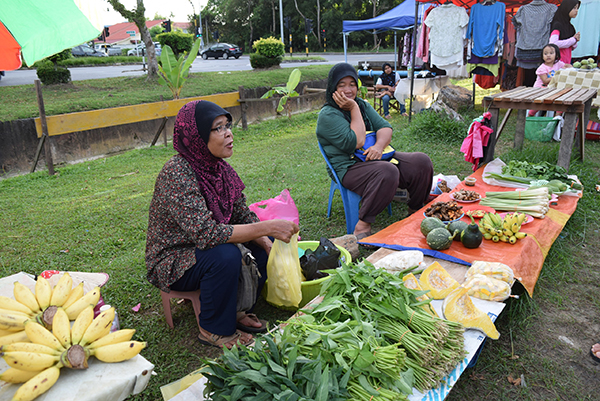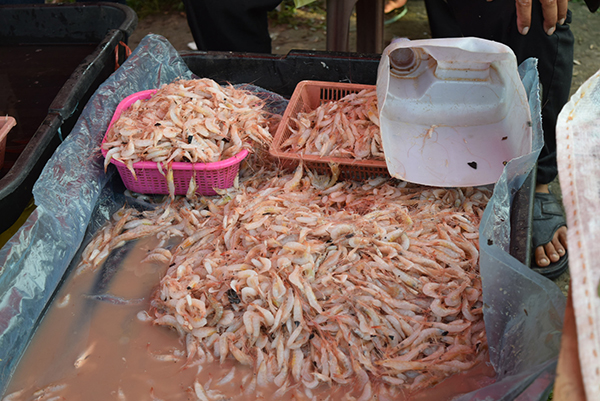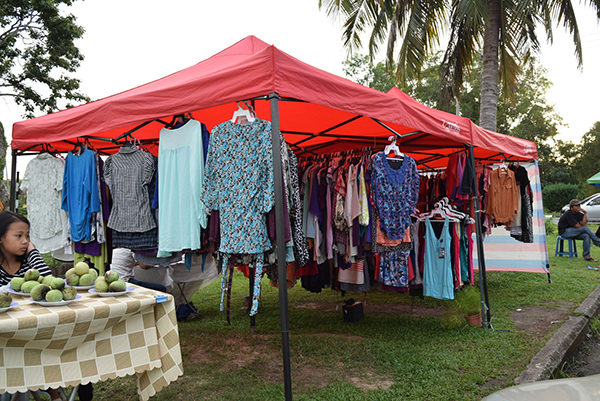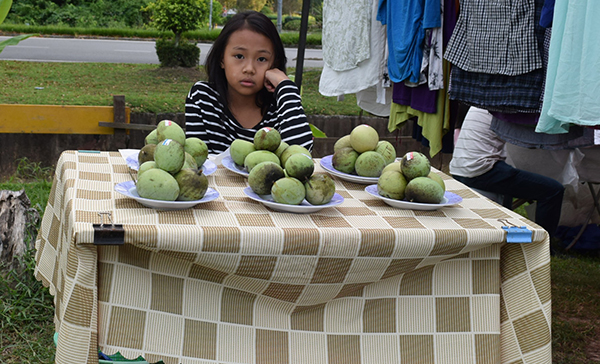
Women from Kelulit selling their vegetables in Luak BayTamu.
MORE than 20 stalls have been set up at the car park outside Luak Bay shophouses to serve residents of the booming area since last year.
This new development in the form of a Tamu or makeshift open-air market has made the Luak Shopping Centre very busy and overcrowded, especially in the evenings.
It is a much welcome move for the suburban residential area, consisting of one secondary school, one primary school, several kampungs and more than 10 housing estates, including Ocean Park, Shangrila, Yong Estate, Hyde Park, Grace and Hill Top Gardens.
The vendors have set up their businesses with great determination to meet the economic challenges of the second decade of the 21st century. One of the things they did was cultivating vegetables or plants like bananas or papayas behind their ‘makeshift stalls’ to stake their ‘occupation’ of trading space.
The new Luak Bay Tamu is on every day but only in the evening to catch the office workers and housewives after five. Most of the stallholders are vegetable and fruit vendors with several local fruit growers doubling up as producer-sellers to increase their takings. They bring to the market different kinds of ferns, wild mushrooms, tapioca and other fruits.
The fishmongers from the two or three stalls at this traditional ad hoc outdoor market sell their catchfrom the nearby sea. The fish can be so fresh that it whets the appetite just looking at them. The marine fare on offer vary from small to big and known to unknown.The fishermen are licensed and have their own boats.
Ali (not his real name), a Kampung Luak resident and long-time fisherman, said: “My friends and I have decided to sell our fish here because there are many customers. Also having a stall means even if it is stormy during the Landas, we can still earn some income selling vegetables, fruits and other produce. This year, we have been a bit luckier so far because the seas are productive and the winds not too strong. Luak Bay has slightly more fish these few days. God has been merciful.”
Most of the vendors are from Kampung Luak which got its name from the Kedayan ancestors who settled here more than 100 years ago. Luak means Bay. So Luak Bay actually means Bay Bay. Some of the vendors come from as far as Kelulit, Beraya, Bekenu or Lambir oil palm estates.

These tiny shrimp, known locally as semuan, are used for making fritters and preserved or dry semuan.
Enjoyable carnival atmosphere
A regular customer Cikgu Selina told thesundaypost she enjoyed the carnival atmosphere, the leisurely shopping and being spoilt for choice.
“After work, I come here to pick up a few items. I do not have to jostle into the supermarkets where the prices may be higher. Some days, I can buy more to stock up. The outdoor shopping is also very refreshing after being cooped up in an air-con building from seven to five,” she said.
Farmer Marin Jiram, who spends quality time shopping with his wife, said going to the Tamu was also an evening out to wind down after a heavy day’s work in the field.
Moreover, he can buy provisions from the nearby Luak Speed Mart and Luak Fresh Mart and even have a cup of Milo at the coffeeshop. There is also a hardware shop which supplies the Luak Bay area with sand, bricks, tiles and paints.
“The air is quite fresh here and the sun not too hot in the evening. It’s nice to be able to buy vegetables from the raised platforms or makeshift tables. People with bad backs need not stoop down or squat to sample the vegetables. The temporary tables are really a good idea,” Marin said.
A young mother who stopped by to buy some hot buns from the Chinese aunty, noted there was a stall selling clothing at the end of the row. However, she hoped the vendors would also sell potted plants.
“This will be good for business. More people will be encouraged to drop by and buy other provisions besides potted plants.”
She said most of the nurseries in Miri were too far for her to visit, especially when pressed for time.
The most popular are still the kuih and drinks stalls on the other side of the block. One stall even provides a table for the elderly but unfortunately, there are no hot drink stalls. In fact, there is not enough space for people to meet up for coffee, a chat and perhaps a halal snack.

This clothing vendor gets some of his goods online or from wholesalers in Miri.
Good relationship
A relative of a retired Baram headmaster is now doing brisk business selling fruits and vegetables on her own at the Tamu. She used to live in Kelulit but now has a home in Kampung Luak.
She is a mother of seven children, four of whom are working and living in Peninsular Malaysia.
She said the customers and vendors had a good relationship — a certain kind of understanding.
Bargains depend on the vendors. Those who might want to close early offer good prices. Sometimes, customers do bargain but it really depends on the situation.
“It’s nice to do some business here. I can earn my own pocket money and get to chat with people,” she said, adding that five years ago, Luak Bay was very quiet but now she could see the whole area being developed.
“It’s good if all of us here, selling all these produce, can help people from all walks of life.”
Mr Huong, one of the shopowners, is upbeat about the development of the new Tamu right in front of his shop.
“It’s good that local food production is healthy. People now cannot afford imported food. Tinned stuff can cost as much as RM8 — like sardines in tomato sauce, for instance — due to higher foreign currency exchange. I still prefer fresh fish which is much better, especially for children and seniors,” he said.
One teacher was particularly happy durians and other local fruits were sold from vehicles.
“The prices are very fair and I don’t have to drive another 10km to Tamu Muhibbah to buy them.It’s really a good service that venders can sell directly from their vehicles. We also get to know the supply sources of our local fruits.”
Fruits are usually from Long Lama and Marudi. For the fruit sellers, doing business at the Tamu is better than crashing into the business of the licensed hawkers of Tamu Muhibbah or Pasar Tani at Saberkas. After all, these fruit sellers from outstation are only seasonal producer sellers.
A van driver doing side business selling watermelons, lime, fresh corn and sweet potatoes, said he liked trading in the area because — as he had noticed — most of his customers were from different races.
“The lMalaysia spirit in the new Tamu Luak is very strong. I like that. If I am in good health, I can come down from Bekenu with my fruits and do some business. If I don’t feel well, I just sell my fruits to the middlemen who come to my farm. But I don’t get good money like that. Coming to Luak is like a good day out for me. I watch people, make some money and I am happy… then I go home,” he added.
By 6.45pm, the sellers pack up and head home. All the rubbish has been cleared and the makeshift tents taken down but the tables remain to remind passers-by of another successful trading day at the Tamu.
The pumpkin vine will be growing longer in the night. And perhaps the flowers of the papaya tree will start to blossom as well.

A little girl looks after her family’s mango stall.
